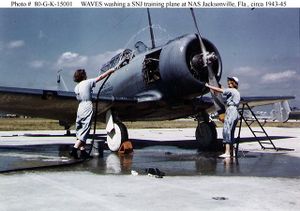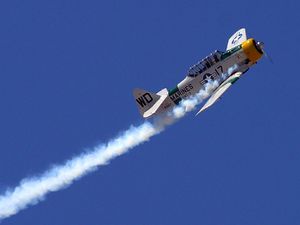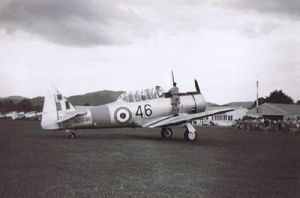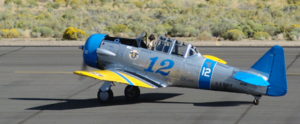PlaneSpottingWorld welcomes all new members! Please gives your ideas at the Terminal.
T-6 Texan
| T-6 Texan/SNJ/Harvard | |
|---|---|
| Type | Trainer aircraft |
| Manufacturer | North American Aviation |
| Maiden flight | 1935-04-01 |
| Number built | 15,495 |
| Variants | CAC Wirraway |
The T-6 Texan was a single-engine advanced trainer aircraft designed by North American Aviation, used to train fighter pilots of the United States Army Air Forces, United States Navy, Royal Air Force and other air forces of the British Commonwealth during World War II. The T-6 is known by a variety of designations depending on the model and operating air force. The USAAC called it the "AT-6", the US Navy, the "SNJ", and the Commonwealth air forces, the Harvard. It remains a popular warbird aircraft.
Contents
Development
The T-6 originated from the North American NA-16 prototype (first flown on April 1, 1935) which, modified as the NA-26, was submitted as an entry for a USAAC "Basic Combat" aircraft competition in March, 1937. The first model went in to production and 180 were supplied to the USAAC as the BC-1 and 400 to the RAF as the Harvard I. The US Navy received 16 modified aircraft, designated the SNJ-1, and a further 61 as the SNJ-2 with a different engine.
A further 92 BC-1A and three BC-2 aircraft were built before the shift to the "advanced trainer" designation, AT-6, which was equivalent to the BC-1A. The differences between the AT-6 and the BC-1 were new squared-off wingtips and a straight-edged rudder, producing the definitive Texan appearance. The AT-6 was designated the Harvard II for RAF/RCAF orders and 1,173 were supplied by purchase or Lend Lease, mostly operating in Canada as part of the Empire Air Training Scheme.
Next came the AT-6A which was based on the NA-77 design and was powered by the Pratt & Whitney R-1340-49 Wasp radial engine. The USAAF received 1,549 and the US Navy 270 (as the SNJ-3). The AT-6B was built for gunnery training and could mount a .30 in machine gun on the forward fuselage. It utilised the R-1340-AN-1 engine which was to become the standard for the remaining T-6 production. Canada's Noorduyn Aviation built a R-1340-AN-1 powered version of the AT-6A which was supplied to the USAAF as the AT-16 (1,500 aircraft) and the RAF/RCAF as the Harvard IIB (2,485 aircraft), some of which also served with the Fleet Air Arm.
The NA-88 design resulted in 2,970 AT-6C Texans and 2,400 as the SNJ-4. The RAF received 726 of the AT-6C as the Harvard IIA. Modifications to the electrical system produced the AT-6D (3,713 produced) and SNJ-5 (1,357 produced). The AT-6D, redesignated the Harvard III, was supplied to the RAF (351 aircraft) and Fleet Air Arm (564 aircraft). Subsequently the NA-121 design gave rise to 25 AT-6F Texans for the USAAF and 931, as the SNJ-6 for the US Navy. The ultimate version, the Harvard 4 (oftern erroneously referred to as the Harvard IV), was produced by Canada Car and Foundry during the 1950s, and supplied to the RCAF, USAF and Bundeswehr.
Production
The T-6 Texan formed the basis for the Australian Commonwealth Aircraft Corporation Wirraway, of which 755 were built between 1939 and 1946.
A total of 15,495 T-6s of all variants were built.
Service record
During the Korean War and to a lesser extent, the Vietnam war, T-6's were pressed into service as forward air control aircraft. These aircraft were designated T-6 "Mosquito"s [1]. The RAF used the Harvard in Kenya against the Mau Mau in the 1950s where they operated with 20 lb bombs and machine guns against the gangs. Some operations took place at altitudes around 20,000 ft asl. Many small countries used the T-6 in a light attack or counter insurgency role until the 1970s.
Since the Second World War, the T-6 has been a regular participant at air shows, and was used in many movies. For example, in Tora! Tora! Tora! and The Final Countdown, converted single-seat T-6s painted in Japanese markings represent Mitsubishi Zeroes. The New Zealand Warbirds "Roaring 40s" aerobatic team use ex-Royal New Zealand Air Force Harvards.
Operators


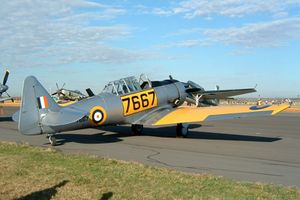
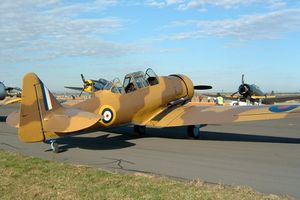
- Template:ARG
- Template:AUS: RAAF, RAN (Wirraway)
- Template:BEL
 Biafra
Biafra- Template:BOL
- Template:BRA
- Template:CAN: RCAF
- Template:ROC
- Template:CHI
- Template:COL
- Template:COG
- Template:CUB
- Template:DNK
- Template:DOM
- Template:ESA
- Template:FRA
- Template:GAB
- Template:GER
- Template:HON
- Template:IND
- Template:ISR
- Template:ITA
- Template:JPN
 Katanga
Katanga- Template:MEX
- Template:MAR
- Template:NLD
- Template:MOZ
- Template:NZL: RNZAF
- Template:NOR
- Template:PAR
- Template:POR
 South Africa: SAAF
South Africa: SAAF- Template:USSR
- Template:SWE
- Template:TUN
- Template:UK: RAF, Royal Navy
- Template:USA: USAAC, USAAF, US Air Force, US Navy
- Template:URU
- Template:VEN
- Template:ZAI
- Template:YUG
Specifications (T-6G / Harvard)
Data from Jane’s Fighting Aircraft of World War II[1]
General characteristics
- Crew: two (student and instructor)
- Length: 29 ft (8.84 m)
- Wingspan: 42 ft (12.81 m)
- Height: 11 ft 8 in (3.57 m)
- Wing area: 253.7 ft² (23.6 m²)
- Empty weight: 4,158 lb (1,886 kg)
- Loaded weight: 5,617 lb (2,548 kg)
- Powerplant: 1× Pratt & Whitney R-1340-AN-1 Wasp radial engine, 600 hp (450 kW)
Performance
- Maximum speed: 208 mph at 5,000 ft (335 km/h at 1,500 m)
- Cruise speed: 145 mph (233 km/h)
- Range: 730 miles (1,175 km)
- Service ceiling: 24,200 ft (7,400 m)
- Rate of climb: ft/min (m/s)
- Wing loading: lb/ft² (kg/m²)
- Power/mass: hp/lb (kW/kg)
Armament
- Provision for 1× 0.30 in (7.62 mm) machine gun
References
- ↑ Jane, Fred T. “The North American Texan.” Jane’s Fighting Aircraft of World War II. London: Studio, 1946. p. 251. ISBN 1 85170 493 0.
External links
- The Canadian Harvard Aircraft Association
- Backgrounder on the Harvard 4 (includes photographs)
- Canadian Harvard Aerobatic Team
- AT-6: School Marm With an Attitude (pilot report)
- Warbird Alley: T-6/SNJ/Harvard page - History, photos, specs, and links
Related content
Related development
CAC Wirraway
Comparable aircraft
Miles Master
Designation sequence
T-2 -
T-6 Texan -
T-28
See also
- T-6 Texan II
- List of military aircraft of the United States
- List of aircraft of the RAF
- List of aircraft of the RNZAF
Lists relating to aviation | |
|---|---|
| General | Timeline of aviation · Aircraft · Aircraft manufacturers · Aircraft engines · Aircraft engine manufacturers · Airports · Airlines |
| Military | Air forces · Aircraft weapons · Missiles · Unmanned aerial vehicles (UAVs) · Experimental aircraft |
| Notable incidents and accidents | Military aviation · Airliners · General aviation · Famous aviation-related deaths |
| Records | Flight airspeed record · Flight distance record · Flight altitude record · Flight endurance record · Most produced aircraft |
de:North American T-6 es:T-6 Texan fa:ت-۶ fr:North American T-6 Texan it:North American T-6 Texan no:North American AT-6 Texan pl:North American T-6 Texan pt:North-American T-6
